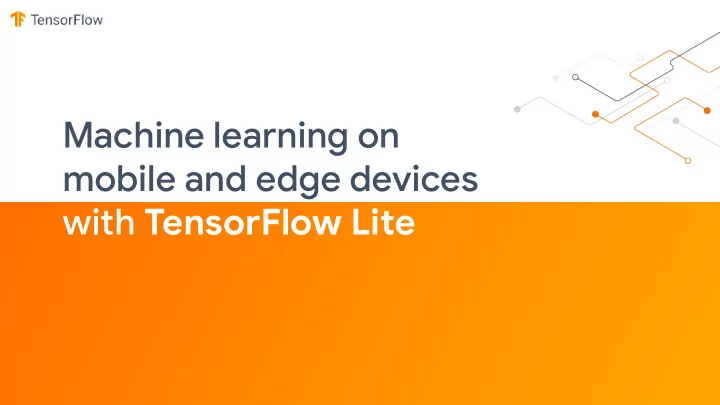

/** With TensorFlow Lite Support Library */ // 1. Load your model. MyImageClassifier classifier = new MyImageClassifier(activity); MyImageClassifier.Inputs inputs = classifier.createInputs(); // 2. Transform your data. inputs.loadImage(rgbFrameBitmap); // 3. Run inference. MyImageClassifier.Outputs outputs = classifier.run(inputs); // 4. Use the resulting output. Map<String, float> labeledProbabilities = outputs.getOutput(): 64
Running Your Model Op Kernels Converuer Interpreter Delegates
Language Bindings Swift Obj-C C & C# ● New language bindings (Swift, Obj-C, C# and C) for iOS, Android and Unity ● Community language bindings (Rust, Go, Flutter/Dart) Rust Go Flutter/Dart
Running TensorFlow Lite on Microcontrollers
What are they? Small computer on IO a single circuit MCU No operating system ● Tens of KB of RAM & Flash ● Only CPU, memory & I/O peripherals ● RAM CPU ROM Exist all around us ●
Class 1 Class 1 Deeper Input Output Input Output Network Class 2 Class 2 MCU MCU Application Processor Is there any sound? Is that human speech?
TensorFlow Lite for TensorFlow Saved Model microcontrollers TensorFlow provides you with a TensorFlow Lite Flat Buffer Format single framework to deploy on Microcontrollers as well as phones TensorFlow Lite Interpreter TensorFlow Lite Micro Interpreter
Example
What can you do on an MCU? Simple speech recognition ● Person detection using a camera ● Gesture recognition using an accelerometer ● Predictive maintenance ●
Speech Detection on an MCU Recognizes “Yes” and “No” ● Retrainable for other words ● 20KB model ● 7 million ops per second ●
Person Detection on an MCU Recognizes if a person is visible in camera feed ● Retrainable for other objects ● 250KB MobileNet model ● 60 million ops per inference ●
Gesture Detection on an MCU Spots wand gestures ● Retrainable for other gestures ● 20KB model ●
Improving your model pergormance
Incredible Pergormance CPU GPU Enable your models to DSP NPU run as fast as possible on all hardware
Incredible Pergormance CPU CPU 2.8x GPU 6.2x EdgeTPU 18.5x 37 ms 13 ms 6 ms 2 ms Floating Quantized OpenCL Quantized point Fixed-point Float16 Fixed-point Mobilenet V1 Pixel 4 - Single Threaded CPU, October 2019
Common techniques to improve model pergormance ● Use quantization ● Use pruning ● Leverage hardware accelerator ● Use mobile optimized model architecture ● Per-op profjling
Utilizing quantization for CPU, DSP & NPU optimizations Reduce precision of static parameters (e.g. weights) and dynamic values (e.g. activations)
Pruning Remove connections during training in order to increase sparsity.
Running Your Model Highly optimized for ARM Op Kernels Neon instruction set Converuer Interpreter Accelerators like GPU, DSP and Edge TPU Delegates Integrate with Android Neural Network API
Utilizing Accelerators via Delegates Op Op Input CPU Operation Kernels Op Interpreter Core Op Op Activation Accelerator Delegate Op
GPU Delegation enables faster fmoat execution 2–7x faster than the fmoating point CPU implementation ● ● Uses OpenGL & OpenCL on Android and Metal on iOS Accepts fmoat models (fmoat16 or fmoat32) ●
DSP Delegation through Qualcomm Hexagon DSP Use Hexagon delegate on Android O & below ● ● Use NN API on Android P & beyond Accepts integer models (uint8) ● Launching soon! ●
Delegation through Android Neural Networks API Enables graph acceleration on DSP, GPU and NPU ● ● Supporus 30+ ops in Android P, 90+ ops in Android Q Accepts fmoat (fmoat16, fmoat32) and integer models (uint8) ●
/** Initializes an {@code ImageClassifier}. */ ImageClassifier(Activity activity) throws IOException { tfliteModel = loadModelFile(activity); delegate = new GpuDelegate(); tfliteOptions.addDelegate(delegate); tflite = new Interpreter(tfliteModel, tfliteOptions); ... } 88
/** Initializes an {@code ImageClassifier}. */ ImageClassifier(Activity activity) throws IOException { tfliteModel = loadModelFile(activity); delegate = new NnApiDelegate(); tfliteOptions.addDelegate(delegate); tflite = new Interpreter(tfliteModel, tfliteOptions); ... } 89
Model Comparison Inception v3 Mobilenet v1 Top-1 accuracy 77.9% 68.3% -11% Top-5 accuracy 93.8% 88.1% -6% Inference latency 1433 ms 95.7 ms 15x faster Model size 95.3 MB 10.3 MB 9.3x smaller 90
Per-op Profjling bazel build -c opt \ --config=android_arm64 --cxxopt='--std=c++11' \ --copt=-DTFLITE_PROFILING_ENABLED \ //tensorflow/lite/tools/benchmark:benchmark_model adb push .../benchmark_model /data/local/tmp adb shell taskset f0 /data/local/tmp/benchmark_model 91
Per-op Profjling Number of nodes executed: 31 ============================== Summary by node type ============================== [node type] [count] [avg ms] [avg %] [cdf %] CONV_2D 15 1.406 89.270% 89.270% DEPTHWISE_CONV_2D 13 0.169 10.730% 100.000% SOFTMAX 1 0.000 0.000% 100.000% RESHAPE 1 0.000 0.000% 100.000% AVERAGE_POOL_2D 1 0.000 0.000% 100.000% 92
Improving your operator coverage
Expand operators, reduce size Utilize TensorFlow ops if op is not natively supporued ● Only include required ops to reduce the runtime’s size ●
Using TensorFlow operators Enables hundreds more ops from TensorFlow on CPU ● Caveat: Binary size increase (~6MB compressed) ●
import tensorflow as tf converter = tf.lite.TFLiteConverter.from_saved_model(saved_model_dir) converter.target_spec.supported_ops = [tf.lite.OpsSet.TFLITE_BUILTINS, tf.lite.OpsSet.SELECT_TF_OPS] tflite_model = converter.convert() open("converted_model.tflite", "wb").write(tflite_model) 96
Reduce overall runtime size Selectively include only the ops required by the model ● Pares down the size of the binary ●
/* my_inference.cc */ // Forward declaration for RegisterSelectedOps. void RegisterSelectedOps(::tflite::MutableOpResolver* resolver); … ::tflite::MutableOpResolver resolver; RegisterSelectedOps(&resolver); std::unique_ptr<::tflite::Interpreter> interpreter; ::tflite::InterpreterBuilder(*model, resolver)(&interpreter); … 98
gen_selected_ops( name = "my_op_resolver" model = ":my_tflite_model" ) cc_library( name = "my_inference", srcs = ["my_inference.cc", ":my_op_resolver"] ) 99
How to get starued
Recommend
More recommend